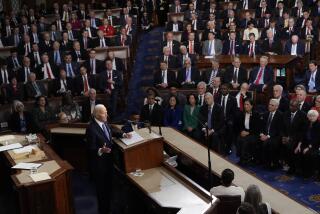Weak August jobs report appears to be anomaly, analysts say
Job growth wilted in August to 142,000, ending a six-month hiring hot streak with the worst performance of the year. But economists cautioned that it was not yet time to panic.
The report from the Labor Department on Friday was a major disappointment. Job creation fell well below analysts’ expectations and dashed growing optimism that the labor market finally had settled into strong and consistent expansion.
The economy had added more than 200,000 net new jobs a month from February through July, the best stretch since 1997.
“We were celebrating a month ago … and maybe we were getting ahead of ourselves,” said Mark Hamrick, Washington bureau chief of Bankrate.com, a financial information website.
The unemployment rate fell a tenth of a percentage point to 6.1% last month, as expected. The drop came because the labor force participation rate also declined, ticking down to 62.8% and matching the lowest level since 1978. About 64,000 people dropped out of the workforce, and so were no longer counted as unemployed.
But other recent data point to an economy that still is strengthening. And economists said last month’s labor market slowdown appeared to be more of an anomaly driven by one-time factors than the start of another stumble in the long recovery from the Great Recession.
“I don’t want to sugarcoat it. This wasn’t a good report,” said Gus Faucher, senior economist at PNC Financial Services Group. “But I do think the economy is better than this, and the labor market is better than this.”
There were some key reasons the August report might have understated the health of the labor market. Those included a strike at a grocery store chain in New England and changes to the summer schedules at auto factories.
August also historically is a difficult month for job creation estimates. The Labor Department has revised up its initial figures for the month by an average of 80,000 jobs over each of the last four years.
Economists expect similar revisions this time.
“When you look at the broader picture that’s emerging, it does show an economy that is gaining more traction,” said Bernard Baumhol, chief global economist at the Economic Outlook Group. “And when you suddenly get a report in the summer that diverges from that, there has to be a certain level of skepticism.”
The Obama administration echoed those sentiments Friday.
“Although the pace of job gains in August was below recent months, the broader trends are moving in the right direction,” said Jason Furman, chairman of the White House Council of Economic Advisers.
Conservatives, however, took a dim view. The report was bad news for the recovery, said Douglas Holtz-Eakin, a former director of the Congressional Budget Office and economic advisor to 2008 Republican presidential nominee John McCain.
“The spin will be to ignore this as a data anomaly, but the reality is that it is another piece of evidence against the notion that the economy will accelerate significantly in 2014,” said Holtz-Eakin, president of the conservative-leaning American Action Forum think tank.
August’s job creation was down sharply from the previous month’s revised figure of 212,000 and the lowest since December. The Labor Department also revised down job growth for June and July by a total of 28,000 positions.
The weak performance is likely to reduce pressure on Federal Reserve policymakers to start raising near-zero interest rates. Some economists have advocated increasing interest rates to reduce the chance of runaway inflation as the recovery strengthens. Inflation, though, has remained low so far.
Some key business sectors, led by retail, performed poorly on the jobs front in August.
The industry shed 8,400 jobs after adding nearly 21,000 in July. A key factor was the loss of 17,000 jobs at food and beverage stores last month.
The Labor Department noted the industry was affected by a strike at the Market Basket grocery store chain in New England. The strike ended last week.
“The strike did take people out of the workforce, and the strike was settled,” said Jack Kleinhenz, chief economist at the National Retail Federation.
He’s still expecting moderate growth in the second half of the year. In a positive sign for retail, the nation’s largest grocery chain, Kroger Co., the parent company of Ralphs in Southern California, said Friday that it would hire 20,000 workers.
Manufacturing was another sector that had a poor August. After adding 28,000 positions in July, manufacturers last month did not increase their payrolls for the first time in more than a year.
A key reason was that employment at motor vehicle and automotive parts factories fell by 4,600, after an increase of nearly 13,000 positions in July.
But those numbers appeared to be misleading. Auto sales have been strong and that led to changes in when the industry shut down factories for the annual summer retooling, which affects the Labor Department’s seasonal adjustments to the jobs numbers.
“Firms in this industry laid off fewer workers than usual for factory retooling in July and recalled fewer workers than usual in August,” said Erica L. Groshen, commissioner of the Bureau of Labor Statistics. “This contributed to a seasonally adjusted increase in July and decrease in August.”
Even with August’s poor performance, job growth is averaging 207,000 during the last three months. Initial jobless claims have been averaging about 300,000 a week, a low level that indicates a healthy labor market. And private readings on manufacturing and service sector growth have pointed toward strong growth.
“There’s been nothing out there right now flashing a red light saying expectations need to be scaled back,” said Hamrick of Bankrate.com. “I really can’t find any reason to believe that this is something that is more than a one-month occurrence.”







